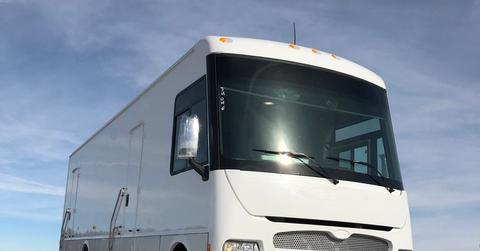This Winnebago RV Is 100% Electric And Zero-Emission
In collaboration with Motiv Power Systems, Winnebago is electrifying their RVs with a new EPIC chassis launched a few months ago. There will be two variations in length of the new RV and it can drive up to 125 miles on a single charge.
Updated May 17 2019, 1:05 p.m. ET
If mass transit vehicles like school buses and trains are going electric, why can’t mobile homes? Winnebago is making their debut with a new RV from Motiv Power Systems that will feature solar panels, along with everything else you’d expect from a motor home. This trend is only expected to get bigger and better.
Winnebago’s new zero-emission commercial vehicle will combine the Class A RV platform with Motiv’s Ford F53-based EPIC all-electric chassis. There will be two different versions in length -- 33 feet and 38 feet -- and the Gross Vehicle Weight Rating will be up to 26,000 pounds. Drivers should expect a range between 85 to 125 miles on a full charge with the vehicles’ six to eight batteries.
“Motiv’s EPIC all-electric chassis, paired with Winnebago Industries’ highly regarded commercial shell, is the perfect fit for end-users who seek reliable performance and functionality,” Jim Castelaz, CEO of Motiv, said in a press release. “We are excited to collaborate with Winnebago Industries as we work together to grow the electric commercial vehicle market.”
Motiv has been transitioning auto companies from fossil fuels with their EPIC medium-duty chassis, or “Electric-Powered Intelligent Chassis.” It’s geared toward bigger vehicles like Winnebago’s motorhomes, or vans, work trucks, and school buses. There are no carbon emissions during use and there are lower operating and maintenance costs.
The EPIC was debuted at the Work Truck Show in Indianapolis last March on a variety of Ford vehicles, including the F-53. It’s been approved under the Electric Qualified Vehicle Modifier program and are “drop-in replacements” for a similar internal combustion engine chassis.
All customizable options are still available for the electrified Winnebago RVs, such as cargo doors, wheelchair lifts, altering where the entrance is located, and various needs for a motorhome (plumbing, air conditioning, etc.). Integrated systems include solar panels and power backup features, potentially paving the way for additional range in the future.
“We have a rich history of product and feature innovation, and we are continuously evaluating new and emerging technologies to further that legacy,” Ashis Bhattacharya, VP of strategic planning and development at Winnebago, said in a press release. “We believe that all-electric vehicle applications continue to evolve to serve numerous end-user needs and this is our first step as a participant in this space.”
Winnebago's new RVs certainly don't have enough range for extended trips, but they are geared toward urban areas. These are ideal units for mobile classrooms or clinics, or it could be a source of emergency backup power when needed. For those still wanting longer trips, you could do worse than sitting in a mobile home waiting for the vehicle to charge.
